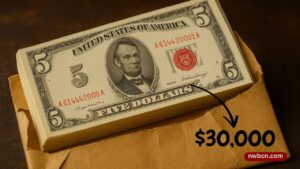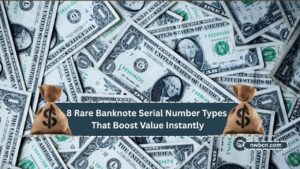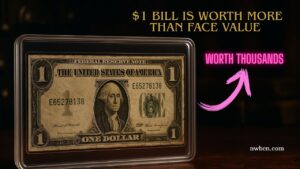The 1957 $1 Silver Certificate—also issued in 1957A and 1957B—belongs to the final era of U.S. currency redeemable in silver bullion.
Though no longer redeemable, these notes are still legal tender, but their true value lies in condition, rarity, and unique features.
Today, collectors seek them for their historic design, distinctive blue seal, and the motto “IN GOD WE TRUST”, which first appeared on Federal currency in 1957.
Why the 1957 Silver Certificate Still Matters
- Final issue of Silver Certificates: After 1963, production ceased due to legislation that removed redemption rights.
- Historical milestones: Included the first use of In God We Trust, and circulated in large quantities—billions printed.
- Collectible potential: Most are worth face value, but star notes, low serials, errors, and uncirculated examples bring significant premiums.
Series and Signature Varieties
| Series | Treasury Signers | Seal Color | Notes Printed |
|---|---|---|---|
| 1957 | Smith (Treasurer) – Anderson (Sec.) | Blue | Billions printed |
| 1957A | Smith – Dillon | Blue | Common small-seal |
| 1957B | Granahan – Dillon | Blue | Late run, slightly scarce |
While most collectors treat these series similarly, Serial and signature blocks offer additional interest, especially star-backed notes.
How to Evaluate a 1957 Certificate
1. Condition and Grading
Most in circulation are Heavily Circulated (VG–F) and trade for $1.50–$5. Crisp notes grade AU–CU and trade at $10–$20, especially if free of faults. Gem Uncirculated (PMG/PCGS 66 EPQ) examples can fetch $30+, though these are uncommon.
2. Specialty Notes
- Star Notes: Print replacements marked with stars can sell for $15–$25 uncirculated.
- Low/interesting serials: Fancy numbers, repeats, or birth years add modest premiums in the $15–$50 range for uncirculated examples.
3. Errors and Printing Variations
Though rare, misprints, inks skips, or folded notes can boost a bill’s value. Examples command $30–$100+, depending on severity and appeal.
Market Value Table
| Grade / Type | Value Range |
|---|---|
| Circulated (VG–F) | $1.50–$5 |
| AU–CU (Sharp, Unbroken Bill) | $10–$20 |
| Gem Uncirculated (PMG/PCGS 66 EPQ) | $30–$50+ |
| Star Notes (Uncirculated) | $15–$25 |
| Low/Fancy Serial (Nice UC) | $20–$50 |
| Notable Errors (Uncirculated) | $30–$100+ |
What Affects Survival and Scarcity
- Mass production: Around 2.6 billion notes printed; most have heavy wear.
- Usage: Circulated heavily until the 1960s; few were kept in pristine condition.
- Redemption: Removed from circulation post-1968, but many stayed in private hands.
Authenticity and Grading: Ensuring Real Value
- Always buy graded notes (PMG or PCGS) for assurance.
- Avoid cleaned, taped, or heavily worn bills, which drastically reduce value.
- Check signatures and seals against known variants.
- Inspect edges and texture for signs of tampering or hidden marks.
Preserving Your Certificate
- Use inert sleeves or archival pages to prevent damage.
- Avoid folding, moisture, or ink transfers.
- Store away from direct light to maintain crispness and color.
The 1957 $1 Silver Certificate may seem ordinary, but its value depends heavily on condition, star status, and serial intrigue. While most are worth only face value plus a small premium, rare uncirculated examples, especially graded or with unique traits, can sell for $30–$100+. By knowing what to look for, even casual finds could be modestly valuable additions to a collection.
FAQs
Q1: Is my circulated 1957 silver certificate worth more than $1?
Likely worth $1.50–$5, depending on wear, folds, or stains.
Q2: What’s a star note and why does it matter?
Star Notes (with a ★ prefix) replace defective prints. They’re rarer and can sell for $15–$25 uncirculated.
Q3: Should I grade my 1957 note?
Yes—grading by PMG or PCGS confirms condition and authenticity, essential if it’s crisp, uncirculated, or has low/fancy serials.




